Input interpretation

hydrogen (chemical element) | rubidium (chemical element) | potassium (chemical element)
Periodic table location
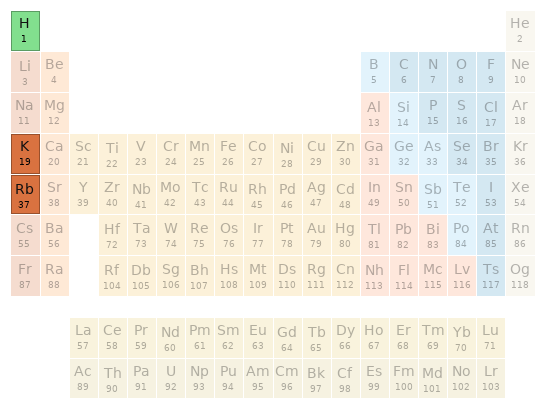
Periodic table location
Images
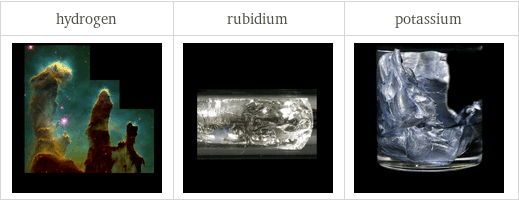
Images
Basic elemental properties
![| hydrogen | rubidium | potassium atomic symbol | H | Rb | K atomic number | 1 | 37 | 19 short electronic configuration | 1s^1 | [Kr]5s^1 | [Ar]4s^1 Aufbau diagram | 1s | 5s | 4s block | s | s | s group | 1 | 1 | 1 period | 1 | 5 | 4 atomic mass | 1.008 u | 85.4678 u | 39.0983 u half-life | (stable) | (stable) | (stable)](../image_source/7bb710980c62bf9969f50e7f72766154.png)
| hydrogen | rubidium | potassium atomic symbol | H | Rb | K atomic number | 1 | 37 | 19 short electronic configuration | 1s^1 | [Kr]5s^1 | [Ar]4s^1 Aufbau diagram | 1s | 5s | 4s block | s | s | s group | 1 | 1 | 1 period | 1 | 5 | 4 atomic mass | 1.008 u | 85.4678 u | 39.0983 u half-life | (stable) | (stable) | (stable)
Thermodynamic properties
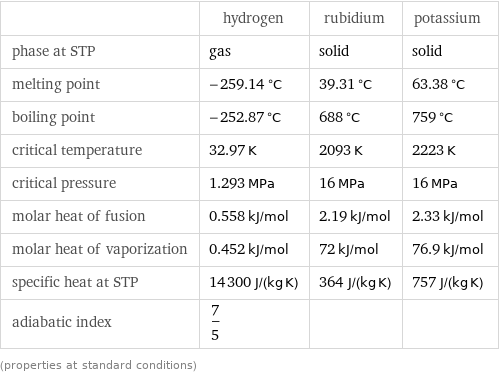
| hydrogen | rubidium | potassium phase at STP | gas | solid | solid melting point | -259.14 °C | 39.31 °C | 63.38 °C boiling point | -252.87 °C | 688 °C | 759 °C critical temperature | 32.97 K | 2093 K | 2223 K critical pressure | 1.293 MPa | 16 MPa | 16 MPa molar heat of fusion | 0.558 kJ/mol | 2.19 kJ/mol | 2.33 kJ/mol molar heat of vaporization | 0.452 kJ/mol | 72 kJ/mol | 76.9 kJ/mol specific heat at STP | 14300 J/(kg K) | 364 J/(kg K) | 757 J/(kg K) adiabatic index | 7/5 | | (properties at standard conditions)
Material properties
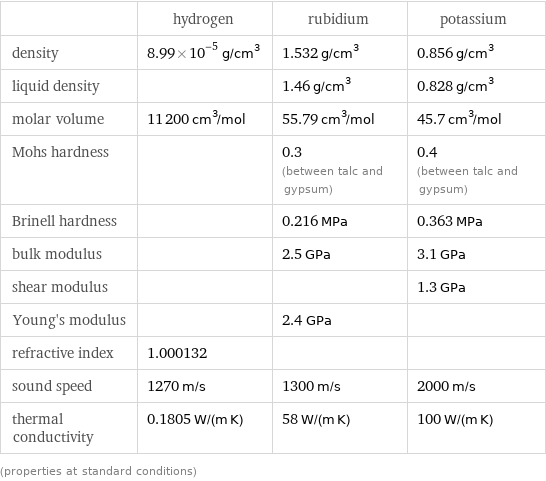
| hydrogen | rubidium | potassium density | 8.99×10^-5 g/cm^3 | 1.532 g/cm^3 | 0.856 g/cm^3 liquid density | | 1.46 g/cm^3 | 0.828 g/cm^3 molar volume | 11200 cm^3/mol | 55.79 cm^3/mol | 45.7 cm^3/mol Mohs hardness | | 0.3 (between talc and gypsum) | 0.4 (between talc and gypsum) Brinell hardness | | 0.216 MPa | 0.363 MPa bulk modulus | | 2.5 GPa | 3.1 GPa shear modulus | | | 1.3 GPa Young's modulus | | 2.4 GPa | refractive index | 1.000132 | | sound speed | 1270 m/s | 1300 m/s | 2000 m/s thermal conductivity | 0.1805 W/(m K) | 58 W/(m K) | 100 W/(m K) (properties at standard conditions)
Electromagnetic properties
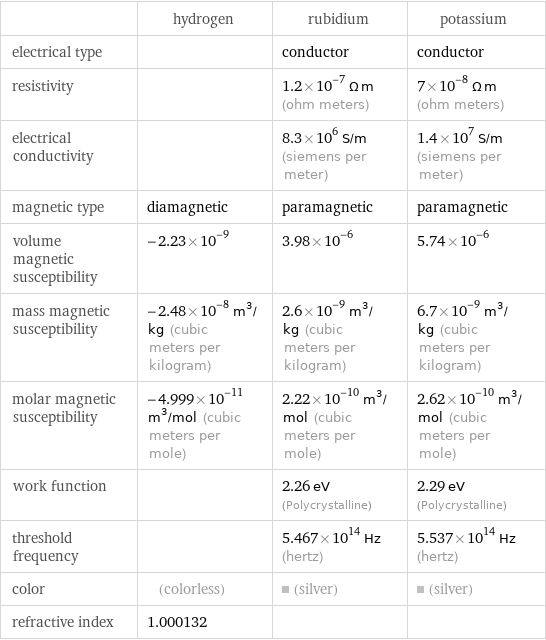
| hydrogen | rubidium | potassium electrical type | | conductor | conductor resistivity | | 1.2×10^-7 Ω m (ohm meters) | 7×10^-8 Ω m (ohm meters) electrical conductivity | | 8.3×10^6 S/m (siemens per meter) | 1.4×10^7 S/m (siemens per meter) magnetic type | diamagnetic | paramagnetic | paramagnetic volume magnetic susceptibility | -2.23×10^-9 | 3.98×10^-6 | 5.74×10^-6 mass magnetic susceptibility | -2.48×10^-8 m^3/kg (cubic meters per kilogram) | 2.6×10^-9 m^3/kg (cubic meters per kilogram) | 6.7×10^-9 m^3/kg (cubic meters per kilogram) molar magnetic susceptibility | -4.999×10^-11 m^3/mol (cubic meters per mole) | 2.22×10^-10 m^3/mol (cubic meters per mole) | 2.62×10^-10 m^3/mol (cubic meters per mole) work function | | 2.26 eV (Polycrystalline) | 2.29 eV (Polycrystalline) threshold frequency | | 5.467×10^14 Hz (hertz) | 5.537×10^14 Hz (hertz) color | (colorless) | (silver) | (silver) refractive index | 1.000132 | |
Reactivity
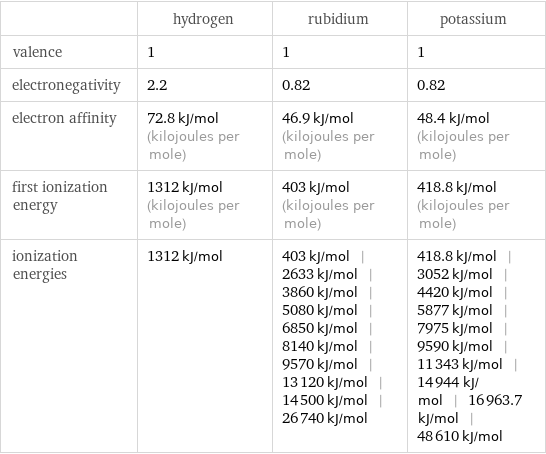
| hydrogen | rubidium | potassium valence | 1 | 1 | 1 electronegativity | 2.2 | 0.82 | 0.82 electron affinity | 72.8 kJ/mol (kilojoules per mole) | 46.9 kJ/mol (kilojoules per mole) | 48.4 kJ/mol (kilojoules per mole) first ionization energy | 1312 kJ/mol (kilojoules per mole) | 403 kJ/mol (kilojoules per mole) | 418.8 kJ/mol (kilojoules per mole) ionization energies | 1312 kJ/mol | 403 kJ/mol | 2633 kJ/mol | 3860 kJ/mol | 5080 kJ/mol | 6850 kJ/mol | 8140 kJ/mol | 9570 kJ/mol | 13120 kJ/mol | 14500 kJ/mol | 26740 kJ/mol | 418.8 kJ/mol | 3052 kJ/mol | 4420 kJ/mol | 5877 kJ/mol | 7975 kJ/mol | 9590 kJ/mol | 11343 kJ/mol | 14944 kJ/mol | 16963.7 kJ/mol | 48610 kJ/mol
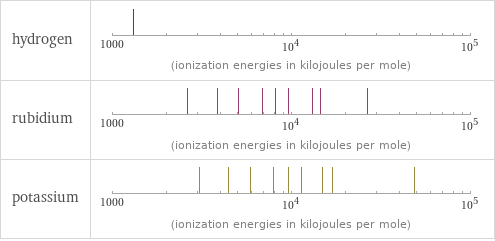
Reactivity
Atomic properties
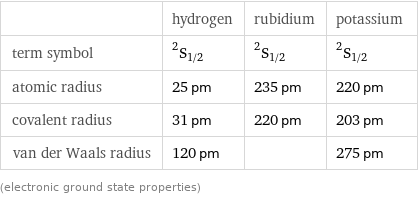
| hydrogen | rubidium | potassium term symbol | ^2S_(1/2) | ^2S_(1/2) | ^2S_(1/2) atomic radius | 25 pm | 235 pm | 220 pm covalent radius | 31 pm | 220 pm | 203 pm van der Waals radius | 120 pm | | 275 pm (electronic ground state properties)
Abundances
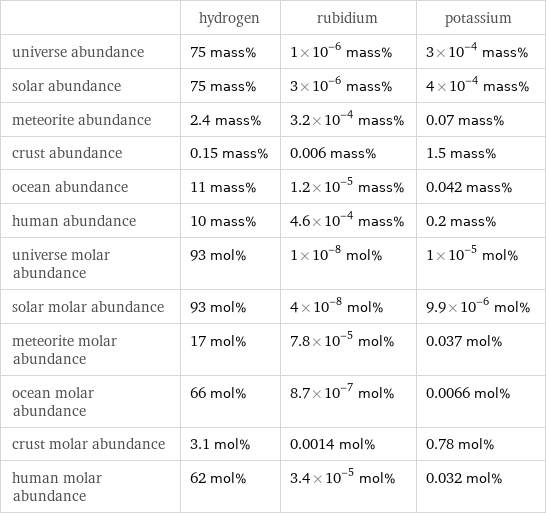
| hydrogen | rubidium | potassium universe abundance | 75 mass% | 1×10^-6 mass% | 3×10^-4 mass% solar abundance | 75 mass% | 3×10^-6 mass% | 4×10^-4 mass% meteorite abundance | 2.4 mass% | 3.2×10^-4 mass% | 0.07 mass% crust abundance | 0.15 mass% | 0.006 mass% | 1.5 mass% ocean abundance | 11 mass% | 1.2×10^-5 mass% | 0.042 mass% human abundance | 10 mass% | 4.6×10^-4 mass% | 0.2 mass% universe molar abundance | 93 mol% | 1×10^-8 mol% | 1×10^-5 mol% solar molar abundance | 93 mol% | 4×10^-8 mol% | 9.9×10^-6 mol% meteorite molar abundance | 17 mol% | 7.8×10^-5 mol% | 0.037 mol% ocean molar abundance | 66 mol% | 8.7×10^-7 mol% | 0.0066 mol% crust molar abundance | 3.1 mol% | 0.0014 mol% | 0.78 mol% human molar abundance | 62 mol% | 3.4×10^-5 mol% | 0.032 mol%